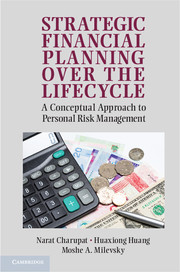Book contents
- Frontmatter
- Contents
- Acknowledgments
- 1 Introduction and Motivation
- 2 Mathematical Preliminaries – Working with Interest Rates
- 3 Personal Balance Sheet and Human Capital
- 4 Consumption Smoothing and Optimal Savings
- 5 Debts, Loans, and Mortgages [Canadian Content]
- 6 Personal Income Taxes [Canadian Content]
- 7 Risk, Utility, and Insurance
- 8 Mortality Risk and Life Insurance
- 9 Investment and Diversification
- 10 The Mathematics of Portfolio Diversification
- 11 Housing Decisions
- 12 Pensions and Retirement [Canadian Content]
- 13 Advanced Material: Part I. Continuous Time and the Calculus of Variations
- 14 Advanced Material: Part II. Stochastic Optimal Control and the HJB Equation
- 15 Concluding Thoughts and Next Steps
- Bibliography
- Index
11 - Housing Decisions
Published online by Cambridge University Press: 05 June 2012
- Frontmatter
- Contents
- Acknowledgments
- 1 Introduction and Motivation
- 2 Mathematical Preliminaries – Working with Interest Rates
- 3 Personal Balance Sheet and Human Capital
- 4 Consumption Smoothing and Optimal Savings
- 5 Debts, Loans, and Mortgages [Canadian Content]
- 6 Personal Income Taxes [Canadian Content]
- 7 Risk, Utility, and Insurance
- 8 Mortality Risk and Life Insurance
- 9 Investment and Diversification
- 10 The Mathematics of Portfolio Diversification
- 11 Housing Decisions
- 12 Pensions and Retirement [Canadian Content]
- 13 Advanced Material: Part I. Continuous Time and the Calculus of Variations
- 14 Advanced Material: Part II. Stochastic Optimal Control and the HJB Equation
- 15 Concluding Thoughts and Next Steps
- Bibliography
- Index
Summary
Learning Objectives
You will recall from Chapter 3 that for most people during most of their lives, human capital is the most valuable asset on their personal balance sheets. Have you ever thought about what asset is next in line – what your second most valuable asset is? It probably would not surprise you to learn that for homeowners, this spot is occupied by their personal residences. Although home-ownership rates (as percentages of households) vary from one country to the next, they currently exceed 60% in many countries such as the United States, Canada, Great Britain, Singapore, and Spain. For homeowners, the value of their houses represents a sizable portion of their total assets.
In this chapter, we examine housing decisions. Specifically, you will learn how to decide between buying and renting a house.
Buying or Renting?
The decision between buying and renting a house is a difficult one because it depends not only on financial considerations, but also on lifestyle choices and personal circumstances. We will start from a purely financial perspective.
From a Purely Financial Perspective
To make a decision based strictly on financial considerations, you need to consider the cost and payoff of each alternative. If you rent, the only expenses that you have are the rental expense and tenant's insurance expense. Tenant's insurance covers your possessions (which can be lost due to theft, fire, or water damage) and liability from any damage that you cause to your building or other people who live there. Both of these expenses are recurring monthly expenses that you have to pay as long as you rent the property.
- Type
- Chapter
- Information
- Strategic Financial Planning over the LifecycleA Conceptual Approach to Personal Risk Management, pp. 224 - 237Publisher: Cambridge University PressPrint publication year: 2012

